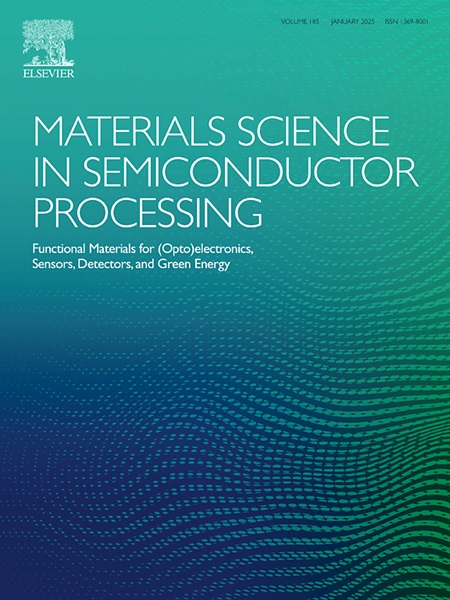新2D Janus MXI (M=Cd, Zn)的预测X=Br, Cl)单层膜具有优异的电子,光学和光催化性能,用于水分解应用
IF 4.6
3区 工程技术
Q2 ENGINEERING, ELECTRICAL & ELECTRONIC
引用次数: 0
摘要
最近,金属卤化物已经成为一个有趣的二维(2D)材料家族,因其在下一代电子和光电子应用中的潜力而引起了人们的极大兴趣。在这项研究中,我们采用密度泛函理论(DFT)计算来设计和全面研究四种新的Janus单层:ZnBrI, ZnClI, CdBrI和CdClI的结构,电子,光学和光催化性能。我们的研究结果表明,通过从头算分子动力学模拟、内聚能计算和声子色散分析证实,这些单层膜具有动态和热稳定性。MXI (M = Cd, Zn;X = Br, Cl)单层也用哈伯德U修正(DFT + U)的DFT来预测。带隙计算结果表明,采用PBE/PBE + U方法计算得到的ZnBrI和ZnClI单层膜的间接带隙分别为2.18/2.18 eV和2.09/2.10 eV;相比之下,HSE06函数的带隙更大,分别为3.07 eV和2.99 eV。相反,使用PBE/PBE + U, CdBrI和CdClI单层膜的直接带隙分别为2.52/2.53 eV和2.37/2.37 eV,而HSE06功能层的带隙分别为3.91 eV和2.73 eV。值得注意的是,这些单层膜在紫外区表现出显著的吸收系数,高达105 cm−1,表明具有很强的光收集能力。CdBrI和CdClI单层在水氧化还原反应中表现出最佳的能带排列,使它们成为有效的水分解光催化剂的优秀候选者。总的来说,我们的研究结果突出了过渡金属卤化物单层作为先进光电器件,高性能太阳能电池和可持续能源应用的有前途的材料。本文章由计算机程序翻译,如有差异,请以英文原文为准。
Prediction of new 2D Janus MXI (M=Cd, Zn; X=Br, Cl) monolayers with excellent electronic, optical, and photocatalytic properties for water-splitting applications
Recently, metal halides have emerged as an intriguing family of two-dimensional (2D) materials, attracting significant interest for their potential in next-generation electronic and optoelectronic applications. In this study, we employ density functional theory (DFT) calculations to design and comprehensively investigate the structural, electronic, optical, and photocatalytic properties of four new Janus monolayers: ZnBrI, ZnClI, CdBrI, and CdClI. Our results reveal that these monolayers exhibit both dynamic and thermal stability, as confirmed through ab initio molecular dynamic simulations, cohesive energy calculations, and phonon dispersion analyses. The band structures of the MXI (M = Cd, Zn; X = Br, Cl) monolayers were also predicated employing DFT with Hubbard U corrections (DFT + U). The computed band gaps show that the ZnBrI and ZnClI monolayers possess indirect bandgaps of 2.18/2.18 eV and 2.09/2.10 eV, respectively, as calculated with the PBE/PBE + U methods, while. In comparison, the HSE06 functional yields larger bandgaps of 3.07 eV and 2.99 eV, respectively. Conversely, the CdBrI and CdClI monolayers exhibit direct bandgaps of 2.52/2.53 eV and 2.37/2.37 eV, respectively, using PBE/PBE + U, while the HSE06 functional results in bandgaps of 3.91 eV and 2.73 eV, respectively. Notably, these monolayers exhibit remarkable absorption coefficients in the ultraviolet region, reaching up to 105 cm−1, indicating strong light-harvesting capabilities. CdBrI and CdClI monolayers demonstrate optimal band alignments for water redox reactions, making them excellent candidates for effective water-splitting photocatalysts. Overall, our results highlight transition metal halide monolayers as promising materials for advanced optoelectronic devices, high-performance solar cells, and sustainable energy applications.
求助全文
通过发布文献求助,成功后即可免费获取论文全文。
去求助
来源期刊

Materials Science in Semiconductor Processing
工程技术-材料科学:综合
CiteScore
8.00
自引率
4.90%
发文量
780
审稿时长
42 days
期刊介绍:
Materials Science in Semiconductor Processing provides a unique forum for the discussion of novel processing, applications and theoretical studies of functional materials and devices for (opto)electronics, sensors, detectors, biotechnology and green energy.
Each issue will aim to provide a snapshot of current insights, new achievements, breakthroughs and future trends in such diverse fields as microelectronics, energy conversion and storage, communications, biotechnology, (photo)catalysis, nano- and thin-film technology, hybrid and composite materials, chemical processing, vapor-phase deposition, device fabrication, and modelling, which are the backbone of advanced semiconductor processing and applications.
Coverage will include: advanced lithography for submicron devices; etching and related topics; ion implantation; damage evolution and related issues; plasma and thermal CVD; rapid thermal processing; advanced metallization and interconnect schemes; thin dielectric layers, oxidation; sol-gel processing; chemical bath and (electro)chemical deposition; compound semiconductor processing; new non-oxide materials and their applications; (macro)molecular and hybrid materials; molecular dynamics, ab-initio methods, Monte Carlo, etc.; new materials and processes for discrete and integrated circuits; magnetic materials and spintronics; heterostructures and quantum devices; engineering of the electrical and optical properties of semiconductors; crystal growth mechanisms; reliability, defect density, intrinsic impurities and defects.
 求助内容:
求助内容: 应助结果提醒方式:
应助结果提醒方式:


